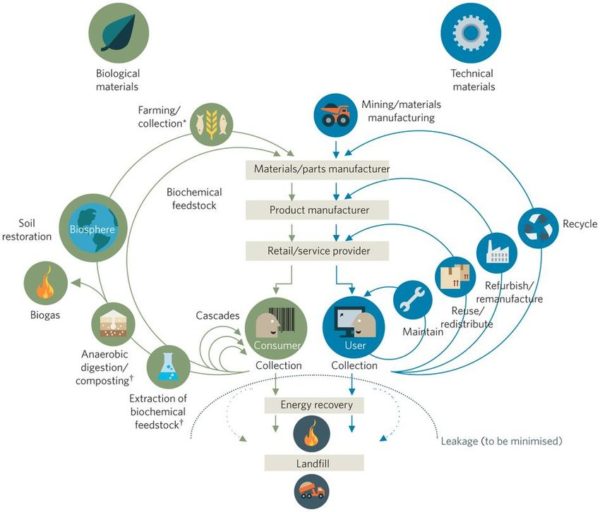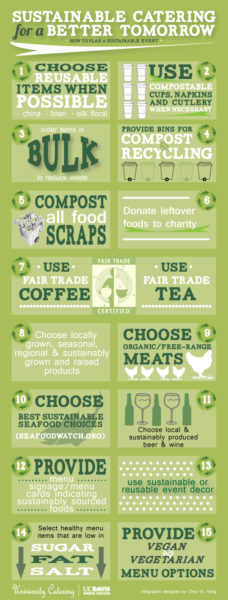What is a circular economy? The case of circular catering and other examples from the Netherlands
This blog by Racher Greer and Susan Pit outline some of the implications of circular economy approaches to catering in the Netherlands, drawing on their research with the WASTE FEW ULL (Waste Food-Energy-Water Urban Living Labs – Mapping and Reducing Waste in the Food-Energy-Water Nexus) project.
The structure of our economy is an important factor in our effort to promote sustainability and protect the environment. We are all familiar with reusing and recycling; these have been “household” terms for years now. A product is reused, recycled, or repurposed whenever possible, before being discarded as waste. Circular Economy (CE) takes a different approach, wherein the reigning goal is not to incrementally reduce the environmental impact from products, but to radically shift to new systems of procurement, cleaner pipe, and end-of-life solutions that contribute to closed loops of materials and energy (Ghisellini et al., 2016; Tukker, 2015; Geissdoerfer et al., 2017). In a circular economy, the goal is to close loops and lessen virgin material extraction from the earth, while retaining the highest value of materials already extracted.
This is achieved by, after reusing a product through its lifetime, recycling the product and its components an ‘infinite’ number of times (Figure 1). The product can be broken down into its parts, and the individual parts are used again. This eliminates both the excessive production of waste, and the necessity of a continuous input of new resources into the system. This is particularly important when some of the components are nonrenewable on a human life’s timescale (for example, lithium used for batteries).

Figure 1: The concept of a circular economy. Source: Ellen MacArthur Foundation circular economy team drawing from Braungart & McDonough and Cradle to Cradle (C2C) via World Economic forum Report.
Only 8.6% of our global economy is circular. Moving towards increasing the global CE is a social challenge that entails international and national law, urban planning and coordinated transport and supply chains. Community and individual lifestyle changes towards ethical consumerism, reorganizing living conditions (e.g., ecovillages, eco-municipalities and sustainable cities), reappraising economic sectors (permaculture, green building, sustainable agriculture), or work practices (sustainable architecture), using science to develop new technologies (green technologies, renewable energy and sustainable fission and fusion power), or designing systems in a flexible and reversible manner that conserve natural resources.

Within that context, the Dutch government has set an ambition for the Netherlands to become fully circular by 2050 (Ministerie van Algemene Zaken, 2019). To reach this goal, the focus lies first with transforming different pilot sectors – one including a new form of catering. Worldwide, around one-third of all food produced for human consumption is lost or wasted, which accounts for an estimated 8% of annual greenhouse gas emissions (FAO, 2011; CAIT, 2018), hence transforming sectors in the food industry towards a circular future is particularly important. The Ministry’s vision of circular catering has been defined to encompass: procurement (choosing products that apply circular principles), production (increasing recyclable bio-based raw materials for disposables, with as little mono-packaging as possible), business operations (minimally burdensome preparation methods and distribution processes), assortment choice (more vegetable proteins, preferably produced locally), and the use of residual flows (e.g. coffee grounds, tomato stems, beet pulp) (Heijink, 2019).
Rachel Greer and Timo von Wirth are participants in the Belmont Forum Food-Water-Energy Nexus / Sustainable Urbanisation Global Initiative (SUGI) funded WASTE FEW ULL project that takes a transformative research lens into circular catering, building on transition and innovation theory. They explore how an alternative catering model – made up of a collection of circular approaches – can be diffused and scaled up, to create a more widespread and transformative impact. They investigate the factors that played a role in the process that transformed circular catering from an alternative niche into being adopted by one of the national ministries.
Drivers for circular innovation uptake and diffusion at a service level included market pressure and peer competition, meeting a growing demand for sustainable alternatives and products, a mandate from a higher-level institute, upholding international treaties, entering climate agreements, contracts negotiated to financially or socially stimulate sustainable alternatives, (inter)national competitions, and a platform for communication that engaged emerging niche innovations with larger, established organizations. They hypothesize that these conditions would also facilitate the furthering of a transition in another industrial, cultural, or political context and speculate that some of the observed principles in cleaner catering would be interesting for other sectors, considering what would be needed for a multi-industry transition to CE. Awareness-raising, testing spaces, common goal-oriented agreements, co-creation, university partnerships, and connecting platforms could also be tools for scaling CE through circular startups in sectors outside of catering. Thus, it would be very valuable for future researchers to study and compare additional similar cases.
Figure 2. Components of circular catering approach adapted by the University of California, Davis catering service.
Want to read more?
Six other examples were recently posted on a blog from the Amsterdam institute for advanced metropolitan solutions featuring ways that companies have adapted their concept to fit the goal of a circular economy. Perhaps this can provide inspiration and motivation for other companies to follow their lead, to work together towards a more sustainable planet.
CAIT (2017). Historical emissions.
FAO (2011). Global food losses and food waste–Extent, causes and prevention. SAVE FOOD: an Initiative on Food Loss and Waste Reduction.
Geissdoerfer, M., Savaget, P., Bocken, N. M., & Hultink, E. J. (2017). The Circular Economy–A new sustainability paradigm?. Journal of cleaner production, 143, 757-768.
Ghisellini, P., Cialani, C., & Ulgiati, S. (2016). A review on circular economy: the expected transition to a balanced interplay of environmental and economic systems. Journal of Cleaner production, 114, 11-32.
Greer, R.L., von Wirth, T., & Loorbach, D.A. (2019). The diffusion of circular services: transforming the Dutch catering sector. Manuscript submitted for publication.
Heijing, R. (2019). Naar een circulaire categorie catering: een visie en actieplan voor het circulair maken van de categorie. Rijkswaterstaat rapport.
Tukker, A. (2015). Product services for a resource-efficient and circular economy–a review. Journal of cleaner production, 97, 76-91.
EU circular economy action plan
US Chamber of Commerce Foundation
World Economic Forum: Form linear to circular—Accelerating a proven concept
<ragraph”>CAIT (2017). Historical emissions.
FAO (2011). Global food losses and food waste–Extent, causes and prevention. SAVE FOOD: an Initiative on Food Loss and Waste Reduction.
Geissdoerfer, M., Savaget, P., Bocken, N. M., & Hultink, E. J. (2017). The Circular Economy–A new sustainability paradigm?. Journal of cleaner production, 143, 757-768.
Ghisellini, P., Cialani, C., & Ulgiati, S. (2016). A review on circular economy: the expected transition to a balanced interplay of environmental and economic systems. Journal of Cleaner production, 114, 11-32.
Greer, R.L., von Wirth, T., & Loorbach, D.A. (2019). The diffusion of circular services: transforming the Dutch catering sector. Manuscript submitted for publication.
Heijing, R. (2019). Naar een circulaire categorie catering: een visie en actieplan voor het circulair maken van de categorie. Rijkswaterstaat rapport.
Tukker, A. (2015). Product services for a resource-efficient and circular economy–a review. Journal of cleaner production, 97, 76-91.
EU circular economy action plan
US Chamber of Commerce Foundation
World Economic Forum: Form linear to circular—Accelerating a proven concept